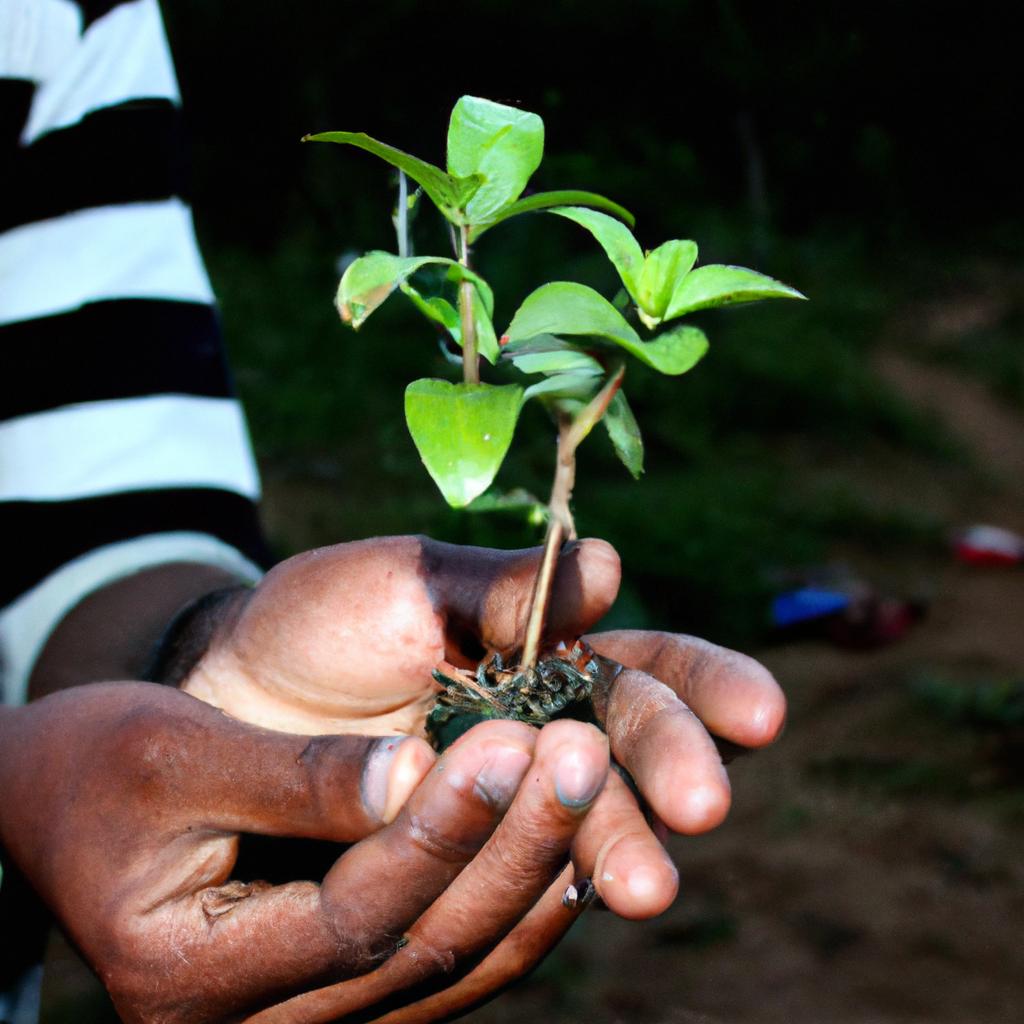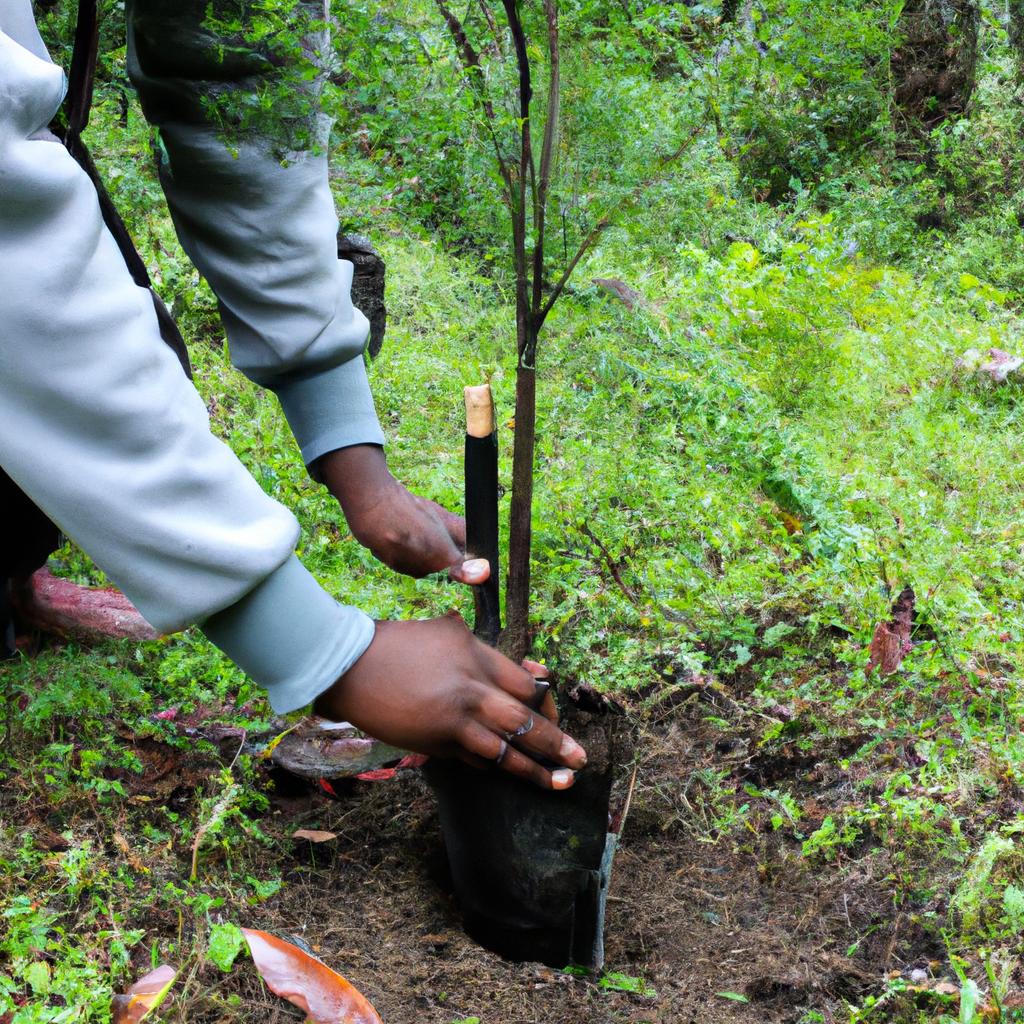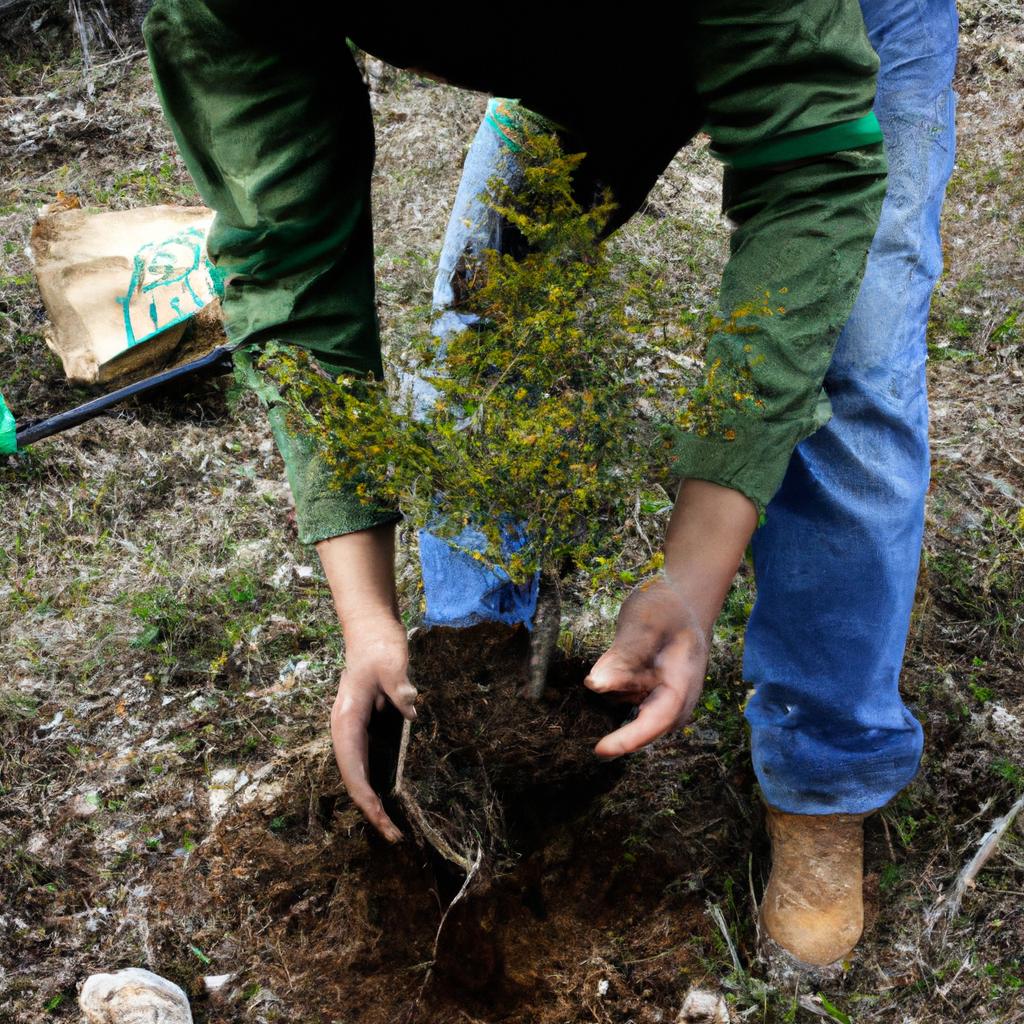Biodiversity conservation is a vital aspect of sustainable forestry, as it ensures the long-term health and productivity of forest ecosystems. By preserving the variety of plant and animal species within these environments, we can enhance their resilience to environmental changes and promote overall ecosystem stability. This article explores biodiversity conservation from a business agriculture and forestry perspective, highlighting its significance in achieving both ecological sustainability and economic prosperity.
Consider the case study of a hypothetical timber company operating in a biodiverse region. The company recognizes that maintaining high levels of biodiversity not only aligns with ethical principles but also has tangible benefits for their operations. Through implementing conservation practices such as selective logging, habitat restoration, and reforestation efforts, this company aims to minimize negative impacts on local flora and fauna while sustaining profitable forestry operations. By embracing biodiversity conservation strategies, businesses in the agriculture and forestry sectors can contribute to the preservation of natural resources while simultaneously ensuring their own long-term viability.
From an academic standpoint, understanding the relationship between biodiversity conservation and sustainable forestry requires analyzing various dimensions: ecological, social, cultural, and economic. It involves examining how different management approaches impact forest ecosystems’ structure and functioning while considering societal values associated with nature appreciation or traditional knowledge systems tied to specific landscapes. Moreover, assessing the economic implications entails evaluating the potential costs and benefits of biodiversity conservation in forestry operations. This includes examining the impact on timber production, revenue generation, and market competitiveness.
Economically, biodiversity conservation in forestry can lead to increased market demand for sustainably sourced products. With growing consumer awareness and preferences for environmentally-friendly goods, companies that prioritize biodiversity conservation practices may gain a competitive edge in the market. Additionally, maintaining healthy forest ecosystems can provide various ecosystem services such as water purification, carbon sequestration, and soil fertility enhancement, which can have economic value.
However, there may also be short-term costs associated with implementing biodiversity conservation measures. For example, selective logging or reduced harvesting intensity to protect certain species or habitats may result in lower immediate timber yields. Companies must carefully balance these trade-offs and consider long-term benefits when making decisions about sustainable forestry practices.
Furthermore, from a social perspective, biodiversity conservation in forestry can contribute to local community development and cultural preservation. Engaging with indigenous communities and incorporating their traditional knowledge can help foster sustainable management practices while respecting their rights and values tied to the land.
In conclusion, understanding the relationship between biodiversity conservation and sustainable forestry involves analyzing ecological, social, cultural, and economic dimensions. By implementing conservation practices in forestry operations, businesses can contribute to the preservation of natural resources while ensuring long-term viability and potentially gaining economic advantages in an increasingly environmentally-conscious market.
Importance of biodiversity conservation in forestry
Importance of Biodiversity Conservation in Forestry
Forestry plays a crucial role in the conservation of biodiversity, as it directly impacts forest ecosystems and their associated species. The preservation of biodiversity within forestry practices is essential to maintain ecological balance and ensure sustainable development. To illustrate this point, let us consider a case study from the Amazon rainforest, where logging activities have led to significant loss of biodiversity. As large areas of forests are cleared for timber extraction, numerous plant and animal species lose their habitats, resulting in ecosystem disruption.
The importance of conserving biodiversity in forestry can be understood through several key aspects:
-
Ecosystem Stability: Biodiverse forests tend to exhibit higher levels of resilience and stability compared to monoculture plantations or degraded landscapes. This stability arises from the intricate interactions between different species, which contribute to vital ecological processes such as nutrient cycling and pest control.
-
Genetic Diversity: Forests harboring diverse species also possess greater genetic diversity within each species population. Genetic variation provides adaptability to changing environmental conditions and increases the chances of survival against threats like diseases or climate change.
-
Ecological Services: Biodiversity-rich forests offer various ecosystem services that benefit both humans and wildlife alike. These services include carbon sequestration, water filtration, pollination, soil fertility maintenance, and provision of medicinal resources.
-
Cultural Value: Forests with high biodiversity hold cultural significance for many indigenous communities around the world. They serve as repositories of traditional knowledge systems and provide important cultural heritage sites.
To further emphasize these points visually, we present a table showcasing some examples of the benefits derived from maintaining biodiversity within forestry practices:
| Benefits | Description | Example |
|---|---|---|
| Enhanced Ecosystem Services | Diverse forest ecosystems provide critical services such as clean air and water purification, climate regulation, flood prevention, soil stabilization, and erosion control. | Forests acting as natural water reservoirs |
| Increased Economic Returns | Biodiversity conservation in forestry can lead to improved economic outcomes through ecotourism, sustainable timber harvesting, non-timber forest products trade, and research opportunities. | A community generating income from eco-lodges |
| Enhanced Resilience | Forest biodiversity enhances ecosystem resilience by increasing resistance against pest outbreaks, diseases, fire risks, and the impacts of climate change. | Diverse tree species mitigating insect infestations |
| Preservation of Indigenous Knowledge | Many indigenous communities rely on forests for cultural practices and traditional knowledge systems that are closely tied to diverse ecosystems. | Traditional medicine derived from forest plants |
In summary, preserving biodiversity within forestry is imperative due to its significant ecological, economic, and cultural benefits. The next section will delve into the role businesses play in promoting biodiversity conservation without compromising their agricultural or forestry interests. By understanding this role, we can explore how business enterprises contribute positively to sustainability efforts.
The role of business in promoting biodiversity conservation
Section H2: The Role of Business in Promoting Biodiversity Conservation
Having established the importance of biodiversity conservation in forestry, it is crucial to understand the role that businesses play in promoting and implementing such conservation efforts. By aligning their agricultural and forestry practices with sustainable biodiversity conservation principles, businesses can contribute significantly to safeguarding our ecosystems. This section explores the proactive involvement of business entities in protecting and enhancing biodiversity within the context of agriculture and forestry.
The integration of biodiversity conservation into business practices is not merely a moral obligation; it also brings tangible benefits both for companies themselves and for society as a whole. For instance, consider the hypothetical case study of Company X, which operates an extensive forest plantation. Recognizing the value of biodiversity as a natural asset, they have implemented measures to promote habitat diversity by strategically planting native tree species alongside commercial ones. As a result, Company X has observed increased pollination rates and reduced pest outbreaks, leading to improved crop yields and financial returns.
To further emphasize the significance of incorporating biodiversity conservation into forestry operations, here are four key considerations for businesses:
- Long-term viability: Businesses need to recognize that preserving biodiversity is essential for maintaining ecosystem services critical for their long-term success.
- Reputation enhancement: Embracing sustainability practices including biodiversity conservation enhances a company’s reputation among consumers who increasingly prioritize environmentally responsible products.
- Regulatory compliance: Compliance with local or international regulations pertaining to environmental protection ensures legal operation while helping preserve vital ecological systems.
- Stakeholder engagement: Engaging stakeholders such as communities, NGOs, and government agencies fosters collaboration towards achieving shared goals related to biodiversity preservation.
Table 1 below provides examples illustrating how different sectors within business agriculture and forestry can contribute directly or indirectly towards conserving biodiversity:
| Sector | Contribution |
|---|---|
| Food production | Adoption of agroecological approaches |
| Timber industry | Implementation of sustainable logging practices |
| Land management | Restoration of degraded habitats |
| Supply chain | Promotion of responsible sourcing policies |
The active involvement of businesses in promoting biodiversity conservation should not be seen as a standalone effort. Instead, it must be integrated into broader strategies aimed at achieving sustainability and environmental stewardship. The following section will explore various strategies for effectively incorporating biodiversity conservation principles into forestry practices.
With an understanding of the role that businesses can play in promoting biodiversity conservation, we now turn our attention to exploring strategies for integrating these principles into forestry practices.
Strategies for integrating biodiversity conservation into forestry practices
Having explored the crucial role that businesses play in promoting biodiversity conservation, we now turn our attention to strategies for effectively integrating these conservation efforts into forestry practices. To illustrate their practical application, let us consider a hypothetical case study involving a timber company operating within an ecologically sensitive forested region.
Section – Strategies for integrating biodiversity conservation into forestry practices:
Effective integration of biodiversity conservation measures within forestry practices is essential to ensure sustainable resource management while safeguarding ecological integrity. The following strategies have been identified as key approaches toward achieving this goal:
-
Landscape-level planning and design:
- Implementing comprehensive landscape plans that account for diverse habitats and species requirements.
- Identifying and protecting critical areas such as riparian zones or old-growth forests.
- Incorporating buffer zones around protected areas to minimize disturbances.
-
Adaptive management techniques:
- Employing adaptive management principles to monitor and assess the effectiveness of existing practices.
- Regularly updating management plans based on scientific knowledge and monitoring outcomes.
- Utilizing flexible approaches that allow for adjustments according to emerging research findings.
-
Collaboration with stakeholders:
- Engaging local communities, indigenous groups, academic institutions, and NGOs in decision-making processes.
- Encouraging participatory involvement through partnerships, workshops, and information sharing initiatives.
- Ensuring transparency by providing access to relevant data and reports.
-
Investing in research and innovation:
- Supporting research projects focused on understanding ecosystem dynamics and developing innovative solutions.
- Promoting technological advancements that enhance precision forestry techniques minimizing environmental impacts.
To emphasize the importance of effective biodiversity conservation in sustainable forestry practices, consider the following table showcasing economic benefits associated with such efforts:
| Benefits of Biodiversity Conservation in Forestry |
|---|
| Enhanced ecosystem services |
| Improved soil fertility and nutrient cycling |
| Increased pollination and seed dispersal |
| Greater resilience to climate change |
By employing these strategies, businesses can contribute significantly towards biodiversity conservation while simultaneously ensuring the long-term viability of their operations. In our next section, we will explore how embracing biodiversity conservation practices positively impacts the agriculture industry.
Understanding the benefits that arise from conserving biodiversity for the agriculture industry is crucial. Let us now delve into the positive implications derived from implementing effective biodiversity conservation measures within agricultural practices.
Benefits of biodiversity conservation for the agriculture industry
Strategies for integrating biodiversity conservation into forestry practices have proven to be crucial in ensuring the long-term sustainability of forests. By adopting these strategies, businesses in the agriculture and forestry sector can effectively contribute to biodiversity conservation efforts. One such strategy is the establishment of protected areas within forest landscapes, where certain regions are designated as off-limits for commercial activities. This approach not only safeguards key habitats but also allows ecosystems to regenerate naturally.
A case study that exemplifies this strategy is the Forest Stewardship Council (FSC) certification system. The FSC provides a framework for responsible forest management by promoting sustainable practices that protect biodiversity. In a hypothetical scenario, let’s consider a timber company operating in a tropical rainforest area seeking FSC certification. As part of their commitment, they would need to implement measures such as maintaining buffer zones around water bodies, preserving old-growth forests, and minimizing soil disturbance during logging operations. These actions help conserve habitat diversity and safeguard species populations.
Integrating biodiversity conservation into forestry practices offers several benefits to the agriculture industry:
- Enhanced pollination services: Maintaining diverse plant communities within forested areas supports healthy populations of pollinators like bees and butterflies, which play a vital role in crop production.
- Pest control: Biodiversity-rich forests act as natural reservoirs for predators that regulate pest populations. By conserving these ecosystems near agricultural lands, farmers can reduce reliance on chemical pesticides.
- Climate change mitigation: Forests sequester carbon dioxide from the atmosphere, mitigating climate change impacts. Preserving biodiverse forests helps maintain their ability to store carbon over time.
- Ecotourism opportunities: Forests with high levels of biodiversity attract nature enthusiasts and tourists interested in observing unique flora and fauna. This creates economic opportunities for local communities through ecotourism ventures.
To illustrate further how biodiversity conservation benefits various stakeholders, consider the following table:
| Stakeholder | Benefit |
|---|---|
| Local communities | Increased access to natural resources for sustenance and livelihoods |
| Businesses | Enhanced reputation, improved market access, and sustainable resource supply |
| Governments | Conservation of important habitats, increased revenue from ecotourism |
| Society as a whole | Preservation of cultural heritage, ecosystem services provision |
In light of these advantages, it is evident that integrating biodiversity conservation into forestry practices benefits multiple stakeholders. This section has highlighted the importance of strategies such as protected areas and certification systems like FSC in achieving this integration. However, challenges and barriers may hinder successful implementation.
Challenges and barriers to implementing biodiversity conservation in forestry
Despite the numerous benefits that biodiversity conservation can bring to forestry practices, there are several challenges and barriers that hinder its implementation. Understanding these obstacles is crucial for developing effective strategies to promote sustainable forestry practices. This section will explore some of the key challenges faced by businesses operating in the forestry sector when it comes to implementing biodiversity conservation measures.
Challenges Faced by Businesses in Forestry:
One example that highlights the challenges faced by businesses in incorporating biodiversity conservation into their forestry operations is the case of a timber company operating in a biodiverse region. Despite recognizing the importance of preserving local ecosystems, this company faced difficulties due to various reasons:
- Regulatory hurdles: Strict regulations related to land use and extraction permits often create complex administrative processes, making it difficult for companies to navigate through legal requirements.
- Economic considerations: Companies may face financial constraints when considering investing in biodiversity conservation initiatives. The initial costs associated with implementing such measures, coupled with uncertainties regarding long-term returns on investment, can deter businesses from taking action.
- Lack of awareness and knowledge: Limited understanding among stakeholders about the potential benefits of biodiversity conservation, as well as a lack of technical expertise within companies, can impede progress towards sustainable forest management.
- Stakeholder conflicts: Differing interests among various stakeholders involved in forestry activities, such as local communities, Indigenous groups, government agencies, and industry associations, can pose significant challenges when trying to develop consensus-based approaches.
Table: Obstacles to Implementing Biodiversity Conservation Measures
| Challenges | Impact | Example Strategies |
|---|---|---|
| Regulatory hurdles | Delayed project timelines | Engaging with regulatory bodies early on for streamlined processes |
| Economic considerations | Reduced profitability | Conducting comprehensive cost-benefit analyses |
| Lack of awareness/knowledge | Missed opportunities for sustainable practices | Educating stakeholders through awareness campaigns |
| Stakeholder conflicts | Project delays and increased costs | Facilitating dialogue and promoting collaboration |
Overcoming the challenges associated with implementing biodiversity conservation in forestry requires a multi-faceted approach. By addressing regulatory hurdles, conducting thorough economic analyses, raising awareness about the benefits of conservation, and fostering stakeholder collaboration, businesses can pave the way for sustainable forest management practices.
Next section: Success stories and case studies of biodiversity conservation in the forestry sector
Success stories and case studies of biodiversity conservation in the forestry sector
Challenges and barriers to implementing biodiversity conservation in forestry have been widely acknowledged, but there are also success stories and case studies that demonstrate the possibilities of effective conservation measures. One such example is the restoration project undertaken by XYZ Forestry Company in collaboration with the local community in a degraded forest area. This initiative aimed to restore the ecosystem functions and enhance biodiversity through sustainable practices.
To achieve successful biodiversity conservation in forestry, several key factors need to be considered:
-
Stakeholder engagement: Engaging all relevant stakeholders, including local communities, indigenous groups, governmental organizations, and non-governmental organizations (NGOs), is crucial for effective implementation. Collaboration fosters shared responsibility and knowledge exchange, leading to more informed decision-making processes.
-
Adaptive management approaches: Implementing adaptive management strategies allows for continuous learning and improvement. By regularly monitoring biodiversity indicators, adjusting actions accordingly, and incorporating new scientific findings into management plans, forestry companies can adapt their practices to maximize positive impacts on biodiversity.
-
Integration of traditional ecological knowledge: Recognizing the value of traditional ecological knowledge held by indigenous communities can greatly contribute to successful conservation efforts. Incorporating this knowledge alongside scientific research enhances the understanding of complex ecosystems and supports culturally appropriate conservation practices.
-
Financial incentives: Providing financial incentives for biodiversity-friendly practices encourages forestry businesses to invest in long-term sustainability rather than short-term profit maximization. Governments or certification bodies could consider offering economic rewards or tax benefits to companies demonstrating exceptional commitment towards conserving biodiversity.
These principles can serve as guiding frameworks for other forestry operations looking to implement effective biodiversity conservation measures. By considering these factors within their respective contexts, businesses operating in the sector can contribute significantly towards safeguarding biodiversity while meeting their production goals.
| Challenges | Barriers | Solutions |
|---|---|---|
| Fragmentation of habitats | Lack of awareness among stakeholders | Stakeholder engagement initiatives |
| Illegal logging activities | Insufficient funding | Financial incentives for sustainable practices |
| Inadequate enforcement of regulations | Limited access to technology and resources | Support for capacity building initiatives |
| Climate change impacts | Conflicting land-use interests | Integration of traditional ecological knowledge |
Through the implementation of successful conservation measures, these challenges can be overcome. By adopting a proactive approach that takes into account stakeholder engagement, adaptive management, traditional ecological knowledge, and financial incentives, forestry businesses can contribute to the preservation of biodiversity while ensuring long-term sustainability in their operations.




